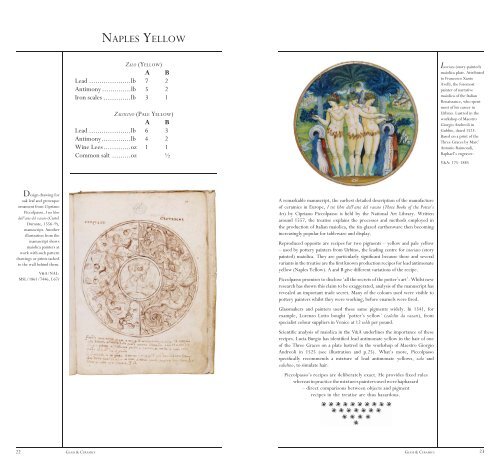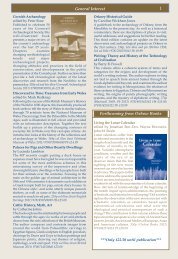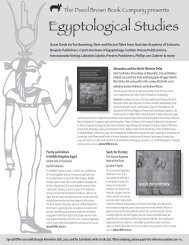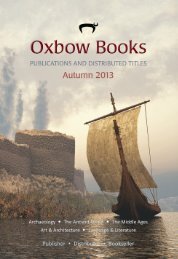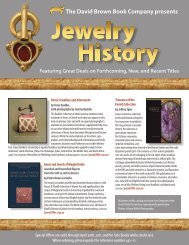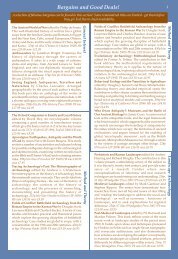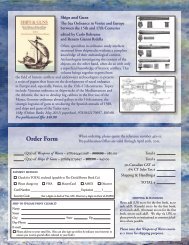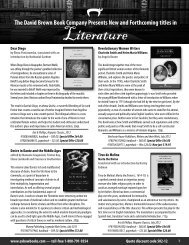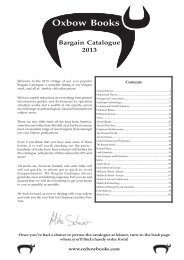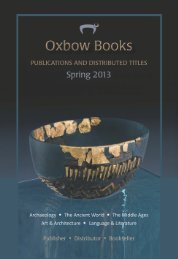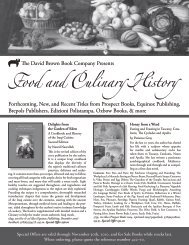NAPLES YELLOW - Oxbow Books
NAPLES YELLOW - Oxbow Books
NAPLES YELLOW - Oxbow Books
Create successful ePaper yourself
Turn your PDF publications into a flip-book with our unique Google optimized e-Paper software.
Design drawing for<br />
oak leaf and grotesque<br />
ornament from Cipriano<br />
Piccolpasso, I tre libri<br />
dell’arte del vasaio (Castel<br />
Durante, 1556–9),<br />
manuscript. Another<br />
illustration from the<br />
manuscript shows<br />
maiolica painters at<br />
work with such pattern<br />
drawings or prints tacked<br />
to the wall behind them.<br />
V&A/NAL:<br />
MSL/1861/7446, f.67r<br />
22 GLASS & CERAMICS<br />
<strong>NAPLES</strong> <strong>YELLOW</strong><br />
ZALO (<strong>YELLOW</strong>)<br />
A B<br />
Lead ....................lb 7 2<br />
Antimony ..............lb 5 2<br />
Iron scales .............lb 3 1<br />
ZALULINO (PALE <strong>YELLOW</strong>)<br />
A B<br />
Lead ....................lb 6 3<br />
Antimony ..............lb 4 2<br />
Wine Lees .............oz 1 1<br />
Common salt .........oz ½<br />
A remarkable manuscript, the earliest detailed description of the manufacture<br />
of ceramics in Europe, I tre libri dell’arte del vasaio (Three <strong>Books</strong> of the Potter’s<br />
Art) by Cipriano Piccolpasso is held by the National Art Library. Written<br />
around 1557, the treatise explains the processes and methods employed in<br />
the production of Italian maiolica, the tin-glazed earthenware then becoming<br />
increasingly popular for tableware and display.<br />
Reproduced opposite are recipes for two pigments – yellow and pale yellow<br />
– used by pottery painters from Urbino, the leading centre for istoriato (story<br />
painted) maiolica. They are particularly signifi cant because these and several<br />
variants in the treatise are the fi rst known production recipes for lead antimonate<br />
yellow (Naples Yellow). A and B give different variations of the recipe.<br />
Piccolpasso promises to disclose ‘all the secrets of the potter’s art’. Whilst new<br />
research has shown this claim to be exaggerated, analysis of the manuscript has<br />
revealed an important trade secret. Many of the colours used were visible to<br />
pottery painters whilst they were working, before enamels were fi red.<br />
Glassmakers and painters used these same pigments widely. In 1541, for<br />
example, Lorenzo Lotto bought ‘potter’s yellow’ (zalolin da vazari), from<br />
specialist colour suppliers in Venice at 12 soldi per pound.<br />
Scientifi c analysis of maiolica in the V&A underlines the importance of these<br />
recipes. Lucia Burgio has identifi ed lead antimonate yellow in the hair of one<br />
of the Three Graces on a plate lustred in the workshop of Maestro Giorgio<br />
Andreoli in 1525 (see illustration and p.25). What’s more, Piccolpasso<br />
specifi cally recommends a mixture of lead antimonate yellows, zalo and<br />
zalulino, to simulate hair.<br />
Piccolpasso’s recipes are deliberately exact. He provides fixed rules<br />
whereas in practice the mixtures painters used were haphazard<br />
– direct comparisons between objects and pigment<br />
recipes in the treatise are thus hazardous.<br />
GLASS & CERAMICS<br />
Istoriato (story-painted)<br />
maiolica plate. Attributed<br />
to Francesco Xanto<br />
Avelli, the foremost<br />
painter of narrative<br />
maiolica of the Italian<br />
Renaissance, who spent<br />
most of his career in<br />
Urbino. Lustred in the<br />
workshop of Maestro<br />
Giorgio Andreoli in<br />
Gubbio, dated 1525.<br />
Based on a print of the<br />
Three Graces by Marc’<br />
Antonio Raimondi,<br />
Raphael’s engraver.<br />
V&A: 175–1885<br />
23
Table mirror.<br />
Hardwood frame<br />
inset with mother of<br />
pearl plaques, with<br />
gilded moresque<br />
embellishments, Venice,<br />
c.1590. The relatively<br />
large size of this mirrorplate<br />
was a 16th-century<br />
development, refl ecting<br />
the rising market for<br />
decorative objects<br />
associated with male and<br />
female grooming and<br />
technological advances<br />
in Venice, a city famed<br />
for its production of<br />
glass. The original plate<br />
would have been a sheet<br />
of glass backed, using<br />
mercury, with tinfoil.<br />
V&A: 506, A&B–1897<br />
34 COSMETICS, SOAPS & PERFUMES<br />
BARBER’S SOAP<br />
To make barber’s soap at little expense<br />
TAKE AS MUCH WHITE SOAP AS YOU LIKE AND CUT INTO SHAVINGS.<br />
Steep in rosewater. Then take powdered orris root [the<br />
root of white lily] and fi nely ground cloves. Incorporate all<br />
together, form into little balls and leave to dry.<br />
Even lather was singled out for moral condemnation in 1583. In his Anatomie<br />
of Abuses, the English Puritan Phillip Stubbes attacked the barber’s trade for its<br />
‘monstrous manners of cuttings, trimmings, shavings and washings’. Amongst<br />
these vices were shaving soaps, which ‘bossed [adorned] the mouth’ with their<br />
lather or rising foam.<br />
The use of soaps, perfumes and cosmetics by men that so incensed Stubbes<br />
is clearly refl ected in books of secrets. The formula above is from the muchreprinted<br />
Difi cio di ricette (House of Recipes) (Venice, 1525), a text that contains<br />
several recipes explicitly directed towards men – dyes for hair and beards<br />
and remedies to combat hair loss. The intended audience of these books was<br />
therefore mixed. Women also copied down similar recipes aimed at men in<br />
their manuscript compilations, reinforcing the view that such collections were<br />
intended for family or household use. Both these cases illustrate a recurrent<br />
theme of this book – the domestication of the Renaissance, where once<br />
innovative style became part of everyday life.<br />
This recipe is advertised as inexpensive. Although books of secrets frequently<br />
include recipes for cheap compound remedies for the poor, the marketing<br />
strategy used here appears to be one of affordable luxury, aimed at the<br />
middling sort. From other sources, we know that such soap-balls could<br />
be bought ready-made from mercers and charlatans and they were considered<br />
as gift items: Francesco Marcolini, the anonymous printer of Ruscelli’s Secreti<br />
di don Alessio Piemontese (see p.11), sent some to his business partner, the<br />
writer Pietro Aretino (who thanked him in the same letter for also sending<br />
perfumed toothpicks).<br />
Since medical theory recognized that aromatics were powerful therapies,<br />
it is likely that this shaving soap was thought to enliven the spirit and senses.<br />
Orris root, for example, was highly regarded as both a medicine and cosmetic.<br />
In Elizabethan England, powdered orris root was used to dust beards. Rosetti<br />
(see p.33) commends it for soaps, scented powders, to remove freckles<br />
and to whiten the hands. In books of secrets and learned medical<br />
texts, it was valued for wound care, enfl amed testicles,<br />
dropsy and for teething rings for babies.<br />
COSMETICS, SOAPS & PERFUMES<br />
Barber-surgeons, etching.<br />
Antwerp, early 1580s.<br />
A satirical etching by<br />
Peeter van der Borcht<br />
(1540–1608), inspired by<br />
an anonymous engraving<br />
De Deken van Ronse, dated<br />
1557. As the image<br />
depicts, besides providing<br />
haircuts and shaves,<br />
barbers bled customers,<br />
pulled teeth and cared<br />
for the entire outer body,<br />
treating skin diseases and<br />
ulcers, dressing wounds<br />
and setting fractures.<br />
Note the use of a double<br />
comb. The fi gure of<br />
the patient being held<br />
down as his teeth are<br />
ripped out with pliers<br />
is recycled in another<br />
print from the series<br />
depicting charlatans (see<br />
p.68). Published as part<br />
of a series of 16 satirical<br />
prints by Philip Galle.<br />
© Rijksmuseum<br />
Amsterdam: FM 418k<br />
35
Image of a Venetian courtesan, from Pietro Bertelli, Diversarum nationum habitus (Padua,<br />
1594). This costume book includes a fl ap allowing the viewer to reveal her hidden secrets:<br />
her underclothes (male breeches) and platform shoes (zoccoli). Courtesans were recognised<br />
as fashion trendsetters. Costume books attempted to differentiate their dress clearly from<br />
noblewomen’s, projecting a nostalgic image of a well-ordered society in which social status<br />
could be easily read through distinct clothing. Similarly erotic scenes of seduction<br />
in gondolas (with fl aps) were readily available.<br />
V&A/NAL: 87.c.195<br />
TEXTILES &<br />
CLOTHING<br />
Venetian Scarlet<br />
Moth Repellent<br />
Stain Remover<br />
Purse Strings<br />
Raising Silkworms
Moths, from a<br />
volume of drawings<br />
commissioned by the<br />
Bolognese naturalist<br />
Ulisse Aldrovandi<br />
(1522–1605), comprising<br />
44 fi gures of insects, 8 of<br />
quadrupeds, 9 of fi sh, and<br />
26 of shells and minerals.<br />
Aged 80, Aldrovandi<br />
published a seven-volume<br />
work, De animalibus<br />
insectis (On Animal Insects).<br />
60<br />
Fondo Aldrovandi,<br />
University of Bologna:<br />
Tavole, Vol. 007,<br />
Animali, f.127<br />
Biblioteca Universitaria<br />
di Bologna. Diritti di<br />
riproduzione. Bologna.<br />
Diritti di riproduzione<br />
How to keep garments of cloth, or<br />
hangings of tapestry, dornicks and say<br />
from eating by moths<br />
BRUSH YOUR APPAREL WITH AN ORDINARY BRUSH AND SIMILARLY<br />
your hangings. Otherwise use a brush made from a fi g frail<br />
[a basket made of rushes used to pack fi gs], until you have<br />
got all the dust out of them. Then brush them thoroughly<br />
two or three times a year as they hang, with a brush made<br />
of wormwood tops. To be sure, rub the reverse side with<br />
wormwood. I have heard that it is customary in summer<br />
time amongst the Italians here to hang walnut-tree leaves on<br />
threads, in such a way that none touches each other. When<br />
thoroughly dried out, they strew them in their chests and<br />
presses [linen cupboards], amongst their clothes and furniture<br />
of their chambers and beds, and between the several folds of<br />
every garment.<br />
TEXTILES & CLOTHING<br />
MOTH REPELLENT<br />
Authors of books of secrets were acutely aware that tapestries and other hangings<br />
were extremely vulnerable to the ravages of moths. Above, Sir Hugh Plat (see<br />
p.55) in his Jewell House of Art and Nature advocates the use of wormwood to<br />
protect them, following ancient authorities such as Pliny and Dioscorides. A<br />
source read and heavily annotated by Plat, the Secrets of Alexis of Piedmont, which<br />
he nevertheless criticized for publishing untested and overly complicated<br />
recipes, reiterates this advice: ‘Take wormwood, or southernwood, the leaves<br />
of a cedar tree, and valerian and lay them in your coffers or presses where your<br />
clothes be, or in the pleats of your garments.’ But Ruscelli’s text also provides<br />
a clear rationale for why these substances in particular were thought to be<br />
effective: ‘These leaves and herbs are bitter of taste, and the savour or smell<br />
is very strong, which the vermin do abhor and cannot abide.’ In Renaissance<br />
Europe, textiles were often stored in cedar or cypress chests, since the natural<br />
resins in these wood were known to be a moth repellent. Shakespeare alludes<br />
to this practice in The Taming of the Shrew, when Gremio mentions ‘In cypress<br />
chests my arras counterpoints’ (tapestry quilts).<br />
From the last decades of the sixteenth century, new compilations of secrets<br />
appeared in England, marketed as household recipe books, with a female<br />
audience in mind. One such text was Plat’s Delightes for Ladies (1602). The fi rst,<br />
though, was John Partridge’s Treasurie of Commodious Conceits and Hidden Secrets<br />
(1573). And this book includes a description of a ‘fumigation for a press and<br />
clothes that no moth shall breed therein’. The recipe calls for a powder made<br />
of cypress wood, juniper, dried rosemary, storax, benzoin and cloves,<br />
combined with a powder from wormwood leaves. These<br />
ingredients were to be set on coals in a chafi ng dish.<br />
TEXTILES & CLOTHING<br />
Tapestry (detail).<br />
Wool and silk, Flanders,<br />
c.1540–55. This<br />
immense tapestry was<br />
woven for the Italian<br />
humanist Paolo Giovio,<br />
and once furnished the<br />
Palazzo Giovio in Como.<br />
Tapestries were usually<br />
reserved for special<br />
occasions and stored<br />
in protective canvas<br />
bags to help preserve<br />
them from damage.<br />
V&A: 256–1895<br />
61
Enamelled gold gimmel<br />
fede ring, Germany.<br />
Its two interlocking<br />
circles join to clasp the<br />
two hands in a widely<br />
recognized symbol of<br />
love and commitment.<br />
The joining of hands was<br />
a signifi cant moment in<br />
the betrothal process,<br />
a tradition enduring<br />
from Roman times.<br />
Inscriptions inside these<br />
rings were common: here<br />
CLEMEN.KESSELR.<br />
DEN-25 AUG AD.1607<br />
may commemorate<br />
the wedding date<br />
of the owner.<br />
V&A: 854–1871<br />
70<br />
FOR HUSBANDS WHO HAVE HAD TOO MUCH SEX WITH THEIR WIVES,<br />
so that they weaken their bodies […] There are many [men],<br />
indeed the majority of the young, who in the fi rst days of<br />
marriage let themselves be so carried away by carnal pleasures<br />
that they fi nd themselves excessively weakened, or lose<br />
their sight, memory, or other accidents befall them […] To<br />
restore lost spirits […] fi rstly it is necessary to comfort and<br />
strengthen the stomach with drinks, compresses and plasters<br />
[…] to improve the digestion. Medicines to warm the heart<br />
are also advisable; in fact they are one of the best things<br />
that can be employed […] During this time, foods should<br />
be delicate and good; and be humid and somewhat hot [in<br />
nature]: such as chickens, partridges, capons and their broth,<br />
from which minestra with egg yolks, a little saffron or other<br />
aromatic and moderately hot spices is made. Avoid eating<br />
too much; and highly nutritious foods and sweet odoriferous<br />
wine are called for. Sheep’s or cow’s milk comfort greatly and<br />
restore the spirits, but must be taken on an empty stomach<br />
in the morning […] white bread soaked in white wine works<br />
fast against weakness. Bathing is highly recommended, but<br />
wash your hands and feet in water, in which roses and willow<br />
leaves have been boiled. Sleep is similarly benefi cial, as by<br />
extension is rest […] a ball made from labdanum, cloves,<br />
musk, sandalwood and saffron, carried in the hand, comforts;<br />
and apothecaries have all these things.<br />
MEDICINE<br />
MEDICINE FOR LOVERS<br />
Renaissance physiology held that regular sex was benefi cial to health, restoring<br />
the balance of the humours, like other forms of evacuation. Excessive sex<br />
though was both debilitating and harmful. It was most dangerous for men:<br />
according to Baldassare Castiglione’s Cortegiano, or Book of the Courtier (1528),<br />
men ‘dry out more than women in intercourse’. This belief rests on a cluster of<br />
ideas transmitted from antiquity, right back to Aristotle: fi rst, that the female<br />
body was colder and wetter; secondly, that sperm was generated from excess<br />
blood remaining after the body was nourished, in conditions of great heat;<br />
thirdly, that sex for men involved a major loss of vital heat and humidity.<br />
Alert to such dangers, the physician Giovanni Marinello (see p.43) in Delle<br />
medicine partenenti all’ infermità delle donne (Medicines Pertinent to Women’s Illnesses)<br />
(Venice, 1563; revised and expanded 1574), provided the sure-fi re remedy<br />
opposite. Diet was central to the conservation of health, so his advice focused<br />
on eating the right nourishing foods.<br />
The ritual exchange of gifts was central to the culture of love and marriage in<br />
the Renaissance. New brides therefore received a special power breakfast after<br />
their fi rst night – which might include eggs for fertility and sweetmeats for love.<br />
In Florence, friends and relatives of the husband’s family offered foodstuffs on<br />
the eve of the wedding and the next day brought small gifts of sweetmeats for<br />
the collation. In Rome, after the exchange of rings, gifts given to the bride by<br />
the husband’s closest relatives included ‘rings or other little presents’. Fede rings<br />
(from the Italian for ‘faith’, ‘trust’) featuring two clasped hands (illustrated<br />
opposite) were wedding rings or love tokens given as signs of everlasting love<br />
and fi delity. Also, images of pierced hearts and joined hands on maiolica<br />
plates (illustrated above) suggest their probable function as<br />
gifts to commemorate and celebrate married love.<br />
MEDICINE<br />
Maiolica dish.<br />
Italy, 1500–10. It<br />
depicts the handclasp,<br />
and was probably a<br />
commemorative gift,<br />
perhaps used during<br />
wedding celebrations.<br />
A pierced heart<br />
surrounded by fl ames<br />
was another popular<br />
design representing love.<br />
V&A: 8900–1863<br />
71
Maiolica scodella, made<br />
in Northern Italy (Castel<br />
Durante), probably<br />
painted by Nicola da<br />
Urbino, c.1533–8. This<br />
bowl is decorated with<br />
typical childbirth scenes<br />
and would have held<br />
nourishing soup for the<br />
new mother. The lid<br />
shows both the birth and<br />
an astrologer divining the<br />
child’s future. A second<br />
scene at the bottom of<br />
the bowl, which depicts<br />
the newborn baby, would<br />
have been revealed when<br />
the bowl was emptied.<br />
V&A: C.2258&A–1910<br />
84 COOKERY<br />
CHICKEN SOUP<br />
To make a tasty broth of capons<br />
SOME CONSIDER THIS BROTH TO BE MARVELLOUS FOR CONVALESCENTS,<br />
but I have made it to order for physicians many times. Take<br />
a capon chopped in pieces as above [as small as possible,<br />
rinsing once to remove any blood, cover with water and<br />
boil], simmer gently in a pan until you have removed all the<br />
scum that rises to the surface. With an earthenware lid over<br />
the pan, leave to simmer for one hour with a thin slice of<br />
prosciutto […] which adds taste to the broth and satisfi es the<br />
listless. Remove the prosciutto […] and add an eighth of an<br />
ounce of cinnamon. Let it reduce by more than half its original<br />
volume, strain through a sieve and make a minestra from<br />
this broth, as it is more suitable for minestre and<br />
little fi ne broths than to give as a drink.<br />
Capons are ‘more nutritious than all other foods […] generate perfect blood<br />
and balance all the humours’, according to Castor Durante, Il Tesoro della sanità<br />
(The Treasury of Health) (1585). The recipe above comes from the fi nal part of<br />
Bartolomeo Scappi’s famous cookbook (see p.87), which deals with foods for<br />
‘convalescents’. This broth was generally considered by physicians like Ulisse<br />
Aldrovandi to be the ideal food to ‘rally the sinking strength of their patients’,<br />
above all for the elderly, the feverish and women in pregnancy and childbirth.<br />
So when the wife of Miho Bunic, a Dubrovnik nobleman, aged 36, contracted<br />
fever after having twins (one of which died instantly after birth), her expert<br />
physician, Amatus Lusitanus, prescribed capon broth and other invigorating<br />
foods (porridge and watermelon seeds). Leonardo Fioravanti (see p.73) in<br />
his Compendio dei secreti naturali (Compendium of Natural Secrets) (Venice, 1564)<br />
supplied a recipe for this broth, ‘called brodo consumato in Rome, sorcicco in<br />
Naples and consumato in Venice’, along with others for highly nutritious ‘little<br />
fi ne broths’ (with eggs, parsley or other herbs) for the sick. He called for sugar<br />
to be added, which Scappi similarly included in his fi rst and longer recipe for<br />
brodo consumato (intended as a drink). Walther Hermann Ryff, the prolifi c author<br />
of books of secrets for ‘the common man’, also provided a recipe for chicken<br />
soup in his Kochbüch für die Krancken (Cookbook for the Sick) (Frankfurt, 1545), for<br />
Germany’s leading publisher, Christian Egenolff.<br />
Special maiolica wares for childbirth (including maiolica and wooden bowls for<br />
these broths) were commonly given as gifts in Renaissance Italy. Illustrated<br />
here from the Piccolpasso manuscript (see p.23) is one example, a fi ve-piece<br />
stacking set, comprising a salt cellar, bowl, trencher, bowl on a high foot and<br />
its lid, ‘a thing of no small ingenuity’. These sets (and simpler ones of just a<br />
bowl plus lid) were referred to as ‘scodella da impagliata’ (childbirth bowls).<br />
Other reviving superfoods given to women before and after birth included<br />
zabaglione, with recipes in both Scappi and La Commare (The Midwife) (Venice,<br />
1596) by the Roman physician Scipione Mercurio. In England, new mothers<br />
were given posset – warm milk curdled with ale, spiced and often thickened<br />
with eggs – and the V&A has several specially designed two-handled posset pots<br />
(in the British Galleries). In Italy, following childbirth, friends and relatives<br />
brought refreshments on specially painted wooden trays (deschi da parto),<br />
generally special treats purchased from apothecaries, such as comfi ts – sugarcoated<br />
aniseed or coriander seeds.<br />
COOKERY<br />
Stacked bowl set for<br />
pregnant women from<br />
Cipriano Piccolpasso,<br />
I tre libri dell’arte del<br />
vasaio (Castel Durante,<br />
1556–9), manuscript.<br />
V&A/NAL:<br />
MSL/1861/7446, f.11r<br />
85
Marbled paper from<br />
the friendship book of<br />
Wolfgang Leutkauff.<br />
This album includes<br />
141 decorated papers<br />
(including 34 types<br />
of marbled paper<br />
on 46 sheets).<br />
V&A/NAL:<br />
MSL/1889/1392. f.80r<br />
104 PRINTING & WRITING<br />
MARBLED PAPER<br />
A way of colouring paper<br />
in a Turkish manner<br />
IMMERSE GUM TRAGACANTH IN VERY PURE WATER FOR THREE DAYS<br />
until it dissolves into a white solution. Then strain and pour<br />
into a trough [the size of a full sheet of paper] […] two to<br />
three fi ngers deep. Watch carefully that its consistency is<br />
neither thicker nor thinner than water […] Light colours<br />
are most suitable: red lake, indigo for sky-blue, orpiment<br />
for yellow and lead white […] Dissolve separately in water<br />
some egg white, ox gall and petroleum […] With a brush<br />
fi rst sprinkle the preparation on the solution. Observe the<br />
drops form fully complete circles on the surface of the paper.<br />
If they do not hold together, pour in some new ox gall and<br />
mix until the desired end is attained. The colours themselves<br />
are sprinkled separately in no exact order.<br />
The method of designing<br />
a plume on paper<br />
WITH A REED DRAW IN ONE DIRECTION ACROSS THE TROUGH<br />
and from side to side, cutting all the drops of colour<br />
and elongating them. You may draw a comb with<br />
equally spaced teeth [and the depth of the trough] along<br />
its length and breadth. Drawing the colours across and cutting<br />
them perpendicularly forms leaves and plumes.<br />
Friendship books (alba amicorum) were the early modern equivalents of<br />
autograph albums or Facebook. They originated amongst students and scholars<br />
from Germany and the Low Countries who collected signatures and dedications<br />
from those they met on their travels. By 1558, as the fashion spread, fi nely<br />
bound blank albums became available. It was customary for students from<br />
noble families to have their contributions embellished by coats of arms painted<br />
by skilled painters at their own expense.<br />
By the mid-1570s, European travellers to the Near East were adding Turkish<br />
decorated papers – marbled paper (abri), silhouette paper and sprinkled paper<br />
– to their albums. These were high-cost items and a street in Istanbul is known<br />
to have specialized in their sale. The marbled and silhouette papers illustrated<br />
here come from a friendship book in the National Art Library belonging to<br />
the Viennese Wolfgang Leutkauff who visited Italy, Istanbul, Adrianople and<br />
Belgrade between 1616 and 1632.<br />
The techniques of marbling were closely guarded. In Europe, Geerard<br />
ter Brugghen only published the fi rst instructions in Amsterdam in 1616.<br />
However, marbled paper was produced in southern Germany from before<br />
1604. The formula above comes from the Ars magna lucis et umbrae (Great Art of<br />
Light and Shadow) (1646), a work on light and optics, by the Jesuit polymath<br />
Athanasius Kircher (1602–80), suggested for the title of ‘the last man who<br />
knew everything’.<br />
Silhouette paper (like marbling, a technique inherited from Iran) was produced<br />
from designs created using thin leather cutouts, soaked in coloured dyes.<br />
These were then printed between folded sheets of paper. The paper was<br />
brushed with a solution of aher (alum and beaten egg whites)<br />
and matt-fi nished with a polishing stone. This<br />
additional treatment added to its price.<br />
PRINTING & WRITING<br />
Silhouette paper from<br />
the friendship book of<br />
Wolfgang Leutkauff.<br />
V&A/NAL:<br />
MSL/1889/1392. f.116r<br />
105


